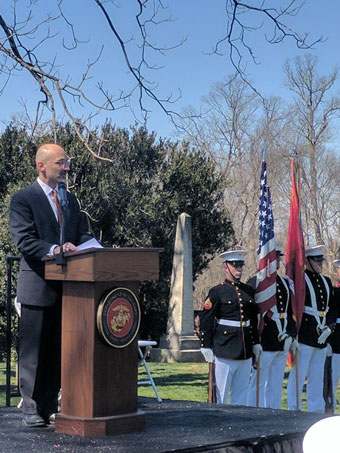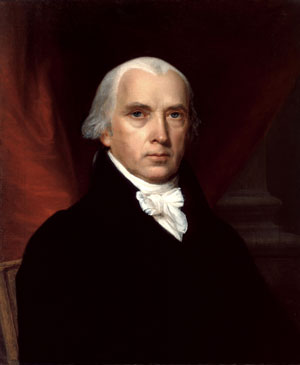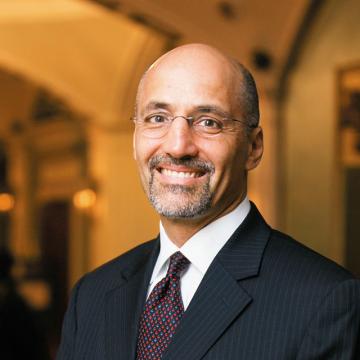Lessons for a new president: James Madison’s five first years
Miller Center Director Bill Antholis' address at the ceremony honoring James Madison’s birthday at his Montpelier home
It is a true honor to be here.
Two years ago, here, at a retreat of the Miller Center’s Governing Council, we embarked on a new project aimed at studying presidential first years, to help guide a new president—whoever he or she might be.
So to honor him, I see five First Year lessons that Madison’s career provides to our new president—or any new president. Madison’s life-long project was to design, build, and operate a representative government. He did so in a way that addressed both the democratic promise and daily existential threats to our republic.

First: democratic promise. In Mr. Madison’s system, in the first year of a presidency, a newly elected president and Congress have a mandate to act.
As Lyndon Johnson once said, “You get one year before the congress stops thinking about you and starts thinking about their own reelection.” In Mr. Madison’s system, a moment of political innovation is followed swiftly by the need for Congress to go back to the people for reelection.
Second: existential threats. Madison understood first years as moments of peril. Foreign policy crises test a new commander in chief. First Year crises are familiar: the Bay of Pigs catastrophe, the Gulf of Tonkin incident, the Tiananmen Square uprising and massacre, the fall of the Berlin Wall, the failed raid in Mogidishu, the 1993 World Trade Center truck bomb and the 9/11 attacks. For better or worse, those crises set the course for each administration’s foreign policy.
Between 1776 and 1817, Madison wrestled with practically every democratic opportunity and foreign challenge to our young nation. Five critical first years stand out. Each provides a lesson for us today.
Madison's first critical first year came in 1784—the first year of a formally new and independent government. The Articles of Confederation were, in short, a mess. Madison, along with Alexander Hamilton and John Jay, convinced George Washington to attend and preside over a Constitutional Convention.
Madison initially was disappointed with the outcome. The powers of the central government were too limited. But he soon learned that states like New York and his own Virginia would not accept a strong central bureaucracy with taxing and war-making power. The lesson of Madison's first First Year was the importance of a powerful central government, but also the acknowledgement that it had to be limited.
Madison's second critical first year was 1789—the first year of a new constitutional government. The newly inaugurated president, George Washington, looked to Madison as his point person in the House of Representatives. The president asked Madison to draft his opening address to the Congress—which Madison did. Madison then drafted the Congressional response. He went on to draft the first laws that established the federal government. He also drafted the Bill of Rights—which he had once opposed—as further checks on federal power.
Most importantly, Madison’s disagreements with Alexander Hamilton emerged—particularly over Hamilton’s plan for the federal government to assume wartime state debt. When combined with the executive’s war making power, Madison feared that the Hamilton central government would revert to old school monarchism.
Still, as we all know, Hamilton and Madison found a compromise. Even in an era when Congress took the lead on legislation, deal-making between the branches and parties was essential. Two clearly demarcated parties were needed to help frame debates and negotiate deals. The lesson of that second first year is that a two-party system depends on compromise . . . and vice versa, that compromise is made easier when two parties are empowered to negotiate.
Madison's third first year was 1801, the first year of Jefferson’s presidency. Madison joined the executive branch as secretary of state.
Prior to 1801, there had never been a peaceful transfer of power from one political party to another. Ever. In human history. Just seven years earlier—1794 in France, the transfer of power was not so peaceful.
Would the Revolution of 1800 be bloody? Would Jeffersonians become Jacobins? Would Federalists hold on to the army and form a shadow government?
Over a decade earlier, Jefferson had written to Madison from France, praising the early days of the French Revolution. “A little rebellion now and then is a good thing.” Two years later, as it began to turn violent, he wrote Madison: “The earth belongs in usufruct to the living, the dead have neither power nor rights over it.” Madison’s reply was more cautious. He recommended “the veneration which time bestows on everything, and without which perhaps the wisest and freest government would not possess the requisite stability.”
By 1801 Jefferson and Madison had won their own revolution, but stability was, indeed, an issue. The new administration faced multiple crises: war between the British and French in the Atlantic, conflict with the Barbary Pirates in the Mediterranean, and potential conflict with the Spanish and French on the Mississippi. Suddenly, a large standing army and healthy federal treasury seemed attractive.
Madisonian restraint prevailed. From the Louisiana Purchase to the shores of Tripoli, the Jefferson administration—led by James Madison’s State Department—used strong Federalist powers and policies to make America great the first time. The lesson: even the most revolutionary of parties should respect and even take advantage of the institutions and policies that they inherit.

Madison's fourth first year was 1809, his own turn as president.
He inherited over-heated politics from Jefferson’s second term. Though Madison had won the White House comfortably, Federalists had surged in the 1808 Congressional elections. A trade embargo favored by the south caused economic harm in northern coastal cities. In the north, calls for secession grew.
Madison aimed for equilibrium. His first inaugural address listed extremes of hot and cold, and Madison aimed for a just-right Goldilocks middle ground. Rather than confront or suppress dissent, Madison acceded to it. In the days prior to his inauguration, Jefferson ended the embargo. That gave Madison time to replenish American coffers, and prepare for a war that he thought was inevitable.
Madison’s great accomplishment in his first year as president was to demonstrate restraint. For while his first term culminated in the war of 1812, he successfully prepared for and conducted that war without having to use central power against domestic opponents.
Finally, Madison had one final first year—and it started almost exactly 200 years ago.
In March 1817 Madison handed the presidency to James Monroe. Within six months, he joined his predecessor Jefferson and successor Monroe in together laying the cornerstone for Central College in Charlottesville. Madison invested his own money and now abundant time into that venture, and worked tirelessly with Jefferson to convince the state legislature to grant a charter for it to become The University.
Former presidents now regularly establish libraries, foundations, and public policy centers. For Jefferson, Madison, and Monroe, the University of Virginia was meant to train citizen leaders. The mission sounds common now. In Madison’s day, most colleges and universities were built to train farmers and businessmen to be loyal subjects to the king. This new university would be different—its core idea was that a democracy could only survive with an educated citizenry.
Madison’s lesson of 1817 was that private and public support for higher education was an investment in self-government. Madison devoted most of his retirement years to that project, eventually becoming rector of the board of visitors.
So to repeat the five lessons for today:
- The lesson of 1784: Central government is important, but it must be limited.
- The lesson of 1789: A healthy two party system depends on compromise, and vice versa.
- The lesson of 1801: Even the most revolutionary administration should still respect the policies and institutions which came before.
- The lesson of 1809: Once in power, seek balance and tolerate dissent.
- The lesson of 1817: Invest in higher education, for an educated citizenry is essential to self-government.
We are honored and blessed by James Madison’s legacy and life, and committed to the evolving art of self-government. Fortunately for us, he helped build a system flexible enough to bring the public’s voice into government, while providing enough institutional strength and stability to weather crises—particularly with foreign powers.
Keeping that system alive is a challenge not just for this or any president, but for all Americans. That may be citizen Madison’s most important lesson of all.
